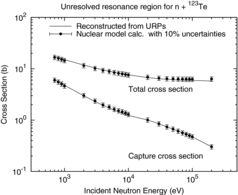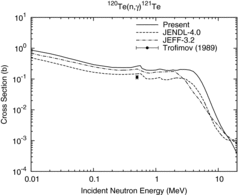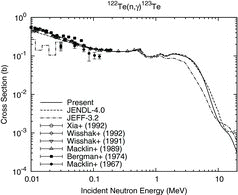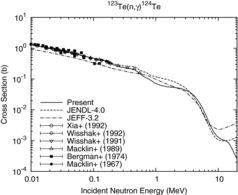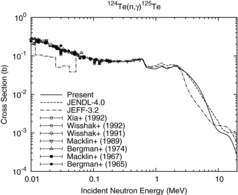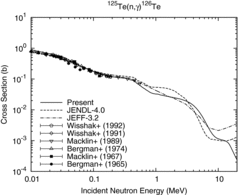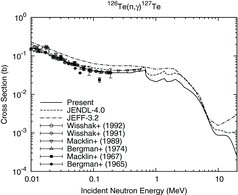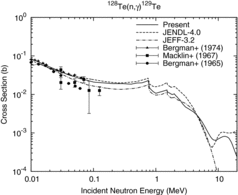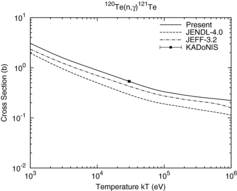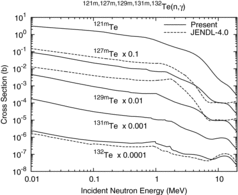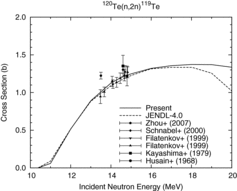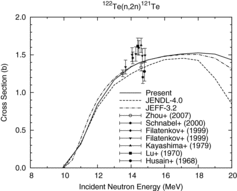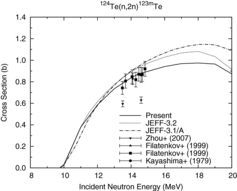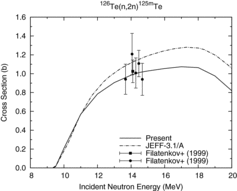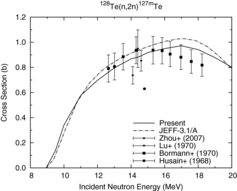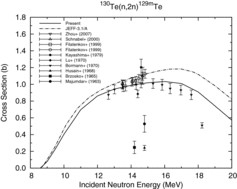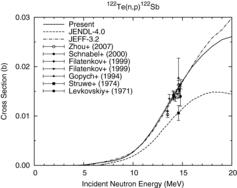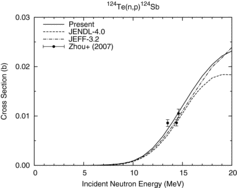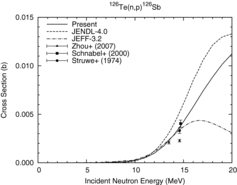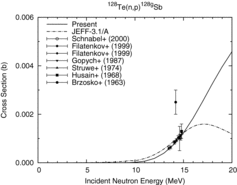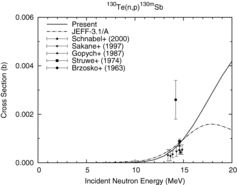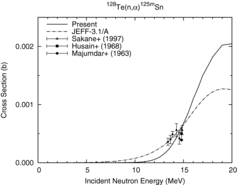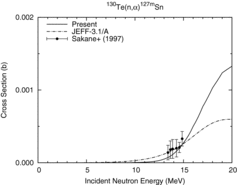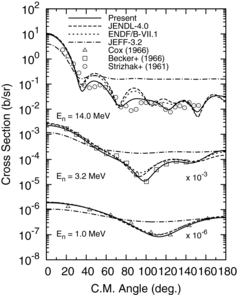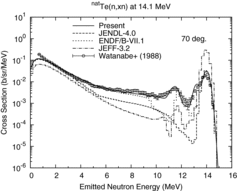 ?Mathematical formulae have been encoded as MathML and are displayed in this HTML version using MathJax in order to improve their display. Uncheck the box to turn MathJax off. This feature requires Javascript. Click on a formula to zoom.
?Mathematical formulae have been encoded as MathML and are displayed in this HTML version using MathJax in order to improve their display. Uncheck the box to turn MathJax off. This feature requires Javascript. Click on a formula to zoom.Abstract
Neutron nuclear data on 13 Te isotopes have been evaluated for the next release of Japanese Evaluated Nuclear Data Library (JENDL) general purpose file in the energy region from 10− 5 eV to 20 MeV. Thermal capture cross sections of 120, 121m, 127m, 129m, 131m, 132Te were determined from the latest measurements or from a simplified formula, although the resolved resonance parameters, which describe the low-energy behavior of cross sections, remain unchanged from JENDL-4.0 for 122, 123, 124, 125, 126, 128, 130Te. A statistical model code was applied to evaluate the cross sections above the resolved resonance region. Coupled-channel optical model parameters were employed for the interaction between neutrons and nuclei. Compound, pre-equilibrium, and direct-reaction processes were considered for cross-section calculation in high-energy region. The present results reproduce experimental data very well, and are found to be much better than the JENDL-4.0 data. The evaluated data are compiled into evaluated nuclear data file (ENDF)-formatted data files.
1. Introduction
The fourth version of the Japanese Evaluated Nuclear Data Library (JENDL-4.0 [Citation1]) was released in May 2010. In this library, 215 nuclides are regarded as fission products in the region from Z = 30 to 68. Although the resolved resonance parameters (RRPs) were examined by reviewing the experimental data that were available then, the fast-neutron region above resolved resonance was re-evaluated for about 170 nuclides due to the deadline of release. Hence, the fast-neutron cross sections for the rest of fission-product nuclides may need further improvements for the next release of JENDL general purpose file. Tellurium isotopes are classified into such nuclides. The data of 128Te were evaluated for JENDL-2 [Citation2] in 1984 without those of other Te isotopes. In 1990, the data of 120, 122, 123, 124, 125, 126, 127m, 128, 129m, 130Te were evaluated and compiled into JENDL-3.1 [Citation3]. These data were essentially carried over to JENDL-3.2 [Citation4], JENDL-3.3 [Citation5], and JENDL-4.0, although the 132Te data were newly evaluated and the RRPs of 122, 125, 126, 128, 130Te were modified for JENDL-4.0. No gamma-ray production data have been evaluated except for 132Te in JENDL-4.0. The direct reaction was not taken into account for the inelastic scattering in the JENDL-3.1 evaluation. Most of the Te data in JENDL-4.0 are based on the measurements and theoretical models which were available more than 20 years ago. Furthermore, neutron-induced activation cross sections of Te isotopes are needed [Citation6] for the decommissioning of light water reactors. Therefore, it is necessary to re-examine the cross sections of Te isotopes.
The present work was undertaken to improve the evaluated data on Te isotopes by considering the latest knowledge on experimental and theoretical nuclear physics. Moreover, the data on 121m, 131mTe were newly evaluated, since these isotopes could be produced through neutron capture by 120Te and 130Te, respectively. In addition, the independent yield of 131mTe, which amounts to 7.11 × 10− 3 [Citation7] for fast-neutron fission of 239Pu, is not small. Evaluated are the total, elastic and inelastic scattering, (n, γ), (n, p), (n, d), (n, t), , (n, α), (n, np), (n, nd), (n, nα), (n, 2n), (n, 3n), (n, 2np) reaction cross sections, the angular distributions of elastically and inelastically scattered neutrons, and the energy distributions of emitted particles and γ-rays in the energy region from 10− 5 eV to 20 MeV. The Q-values of the reactions were calculated from the 2003 version of the mass table (AME2003) [Citation8], and are listed in , together with isotopic abundances [Citation9], half lives [Citation10], and excitation energies [Citation11] of target nuclei. The RRPs remain unchanged from JENDL-4.0. The unresolved resonance parameters (URPs) were obtained by fitting to the calculated total and (n, γ) cross sections.
Table 1. Isotopic abundances and reaction Q-values of tellurium isotopes.
This paper presents how the evaluation was performed. Section 2 deals with the resonance region. In Section 3, the computational methods and procedures above the resonance region are described. Comparisons of the evaluated results with experimental and existing evaluated data are made in Section 4. Finally, Section 5 summarizes the conclusion.
2. Resonance region
The resolved and unresolved resonance regions are given in for each target nucleus. No RRPs are available for 120, 121m, 127m, 129m, 131m, 132Te. The RRPs of 122, 123, 124, 125, 126, 128, 130Te remain unchanged from JENDL-4.0, because no new measurements have been available since the JENDL-4.0 evaluation was performed. Concerning the nuclides for which RRPs are unavailable, the thermal elastic scattering cross sections were calculated as 4πR2, where R stands for the scattering radius that can be estimated from nuclear model calculations in the higher energy region. On the other hand, the thermal capture cross sections of these nuclides except 120Te were estimated from a simplified formula used in the previous work on antimony [Citation12]. This formula gives rough estimates of thermal capture cross sections by using theoretical s-wave γ-ray strength functions. It is used only when no other options are available. The value measured by Eastman and Krane [Citation13] was used to renormalize the 1/v capture cross sections of 120Te at 0.0253 eV. The thermal capture and elastic scattering cross sections are listed in , where capture and elastic scattering cross sections are given at 300 and 0 K, respectively, in order to compare with the values recommended by Mughabghab [Citation14]. There are large differences in the capture cross sections of 127m, 129mTe between the present work and JENDL-4.0. The value of 3381 b for 127mTe in JENDL-4.0 is based on the old recommendation [Citation15], although the origin of 1601 b is unknown for 129mTe. However, no data are found for 127mTe in the new recommendation [Citation14]. The new recommendation gives a value of 8.0 ±0.2 b for the scattering cross section of 124Te, which seems larger than those of other nuclides in the same recommendation. Anyway, it is not possible to judge which one is reasonable, since no experimental data exist.
Table 2. Resolved and unresolved resonance regions.
Table 3. Thermal capture (C) and elastic scattering (E) cross sections in units of barns.
The ASREP code [Citation16] was used to determine the URPs by fitting to the total and capture cross sections calculated in the energy region above 10 eV. It should be noted that the URPs obtained are used only for self-shielding calculations, because the pointwise cross sections are given in the evaluated data files. As an example, the cross sections of 123Te reconstructed from the URPs presently obtained are compared with the total and capture cross sections calculated from the nuclear models in . In the parameter fitting, 10% uncertainties in the nuclear model calculations were assumed. It is found from the figure that the reconstructed cross sections reproduce the nuclear model calculations very well.
3. Computational methods and procedures above resonance region
3.1. Nuclear models
The CCONE code (version 0.8.4) [Citation17] was used for calculating the neutron-induced reaction cross sections of Te isotopes. The code is based on the spherical and coupled-channel optical models, the two-component exciton pre-equilibrium model, the distorted-wave Born approximation (DWBA), and the multi-step statistical model. In order to simulate the direct and semidirect effects on the radiative capture reaction, the pre-equilibrium capture was considered by using the γ-ray emission rate derived by Akkermans and Gruppelaar [Citation18].
3.2. Parameter determination
3.2.1. Optical model potentials
As for neutrons, we employed the global optical model parameters obtained by Kunieda et al. [Citation19] using the coupled-channel method based on the rigid rotor model (RRM-CC) [Citation20]. The potential depths are given as follows:
(1)
(1)
(2)
(2)
(3)
(3)
(4)
(4)
(5)
(5) where Z, A, and N are the atomic number and mass number of a target and N = A − Z, respectively. The symbol E† is the incident-neutron energy (E) relative to the Fermi one (Ef), i.e., E† = E − Ef. The Fermi energy Ef is calculated from neutron-separation energies (Sn) of target and compound nuclei such as Ef = −{(Sn(Z, A) + Sn(Z, A + 1)}/2. The depths VR, WD, WV,
, and
correspond to real volume, imaginary surface, imaginary volume, real and imaginary spin–orbit terms, respectively. The form factor is of a Woods–Saxon shape, i.e.,
(6)
(6) where Ri is written as
(7)
(7) The angle θ refers to the body-fixed system, and Y0l and βl denote spherical harmonics and a deformation parameter, respectively.
From the neutron potentials, transmission coefficients are obtained together with total cross sections, shape elastic scattering cross sections, and the direct-reaction components of inelastic scattering cross sections for the CCONE calculation. It should be noted that renormalization would be done of the reaction cross section calculated from the transmission coefficients when additional DWBA calculation is performed for the inelastic scattering.
The parameters required in Equations (Equation1(1)
(1) )–(Equation7
(7)
(7) ) are listed in , and the coupling schemes and deformation parameters are given in . The deformation parameters were determined by considering the compilation of Raman et al. [Citation21], although their signs and magnitude were adjusted so as to reproduce measured total cross sections. The calculated total cross section is shown in , together with experimental data and the spherical optical model calculations using the parameters of Koning and Delaroche [Citation22]. In order to give a better fit to experimental data, the values of
and
were adjusted, while the rest of the parameters remain unchanged from the original ones [Citation19]. Concerning charged particles, used were the spherical parameters of Koning and Delaroche [Citation22] for protons, those of Lohr and Haeberli [Citation23] for deuterons, those of Becchetti and Greenlees [Citation24] for tritons and 3He, and those of Lemos [Citation25] modified by Arthur and Young [Citation26] for α-particles. The transmission coefficients, which are required by CCONE to calculate charged-particle emission, are obtained from the charged-particle parameters.
Table 4. Optical model parameters for neutrons.
Table 5. Coupling schemes used in the interaction between neutron and target.
3.2.2. Discrete levels and level density
In the calculation, it was necessary to input the discrete levels and level density parameters for 46 nuclei, i.e., 118 − 133Te, 118 − 132Sb, and 116 − 130Sn. The discrete levels were taken from the reference input parameters library RIPL-3 [Citation11].
Concerning the level density, the composite formula of Gilbert and Cameron [Citation27] was used in the present work. In the region of low excitation energy E, the level density is described by the constant temperature formula ρT, namely,
(8)
(8) On the other hand, the a parameter, which characterizes the Fermi-gas part of level density ρF, is defined as
(9)
(9) where
is the shell correction energy and γ a damping factor. The damping factor is given by γ = 0.40A− 1/3 MeV− 1. The energy U is expressed by E and the pairing energy Δ, i.e., U = E − Δ. The values of a(*) and Δ were taken from the work of Mengoni and Nakajima [Citation28]. The shell correction energy
is calculated as the difference between the experimental mass [Citation8] and the theoretical mass [Citation29]. The two parameters T and E0 were determined so as to connect ρF and ρT smoothly at an appropriate matching energy Em. The parameters used in this work are listed in for individual nuclei, together with the energies of the highest discrete levels
.
Table 6. Level density parameters for each nucleus.
3.2.3. Gamma-ray transition
The γ-ray transmission coefficients are related to the photoabsorption cross sections by the detailed balance. The photoabsorption cross section is usually approximated by various Lorentzian shapes. In the present calculation, a modified Lorentzian proposed by Plujko et al. [Citation30] was used for radiation, since its use is recommended by RIPL-3 [Citation11]. The resonance energy (E0), resonance width (Γ0), and peak cross section (σ0) are given [Citation31] by
(10)
(10)
(11)
(11)
(12)
(12) The standard Lorentzian form was used to describe the M1 and E2 radiations for which the parameters were taken from the work of Kopecky and Uhl [Citation32].
In cases where measured capture cross sections are available, the γ-ray strength functions are renormalized so that the calculated cross sections reproduce these data. The -wave γ-ray strength functions are compared in with the values recommended by Mughabghab [Citation14] and those used in the JENDL-4.0 evaluation. The values of 121, 123, 124, 125, 126, 127, 129, 131Te were obtained after renormalization using measurements.
Table 7. Gamma-ray strength functions for s-wave neutron in units of 10−4.
3.2.4. Pre-equilibrium parameters
The version 0.8.4 of CCONE incorporates pre-equilibrium processes for the (n, γ) and first-step binary reactions such as (n, n′), (n, p), (n, d), (n, t), , and (n, α). In the two-exciton pre-equilibrium formalism, the single-particle state densities for protons and neutrons in a residual nucleus are described [Citation33] by
(13)
(13)
(14)
(14) respectively. The parameter C0, of which the default value is unity, is changed so that the calculations reproduce measured neutron and proton emission data such as (n, 2n) and (n, p) in the present work. The (n, 2n) reaction is a ternary reaction, which proceeds from (n, n′) by sequential decay in the framework of the multi-step statistical model. Hence, the (n, 2n) cross section is sensitive to C0 for the residual nucleus in the (n, n′) reaction. More experimental data are available for (n, 2n) than for (n, n′) in the nuclides presently concerned. In addition to the C0's, the parameters for knockout and pickup reactions [Citation34] were adjusted for α emission. The pre-equilibrium parameters used are listed in , where C0's are given only for the residual nuclei in the (n, n′) and (n, p) reactions, and are assumed to be unity for those in the other first-step binary reactions.
Table 8. Pre-equilibrium parameters.
4. Comparison with experimental data and other evaluated data in the fast-neutron energy region
The presently evaluated data are compared with experimental data and other evaluated data. The experimental data are taken from the EXFOR database [Citation35], which is internationally maintained. Concerning the general purpose evaluated nuclear data, there are three major libraries, i.e., JENDL-4.0 [Citation1], evaluated nuclear data file (ENDF)/B-VII.1 [Citation36], and joint evaluated fission and fusion (JEFF)-3.2 [Citation37]. However, the fast-neutron cross sections of ENDF/B-VII.1 except for 130, 132Te were taken from JENDL-3.3 [Citation5], which means that those of ENDF/V-II.1 data are equivalent to the JENDL-4.0 data. To avoid duplication, identical evaluated data are not drawn in the following figures. Except 122, 124, 131mTe in JEFF-3.2, the general purpose libraries do not contain activation cross sections leading to the ground or isomeric state. The activation cross section file JEFF-3.1/A [Citation38] is used for comparison with such activation data. We do not discuss most of the reactions where experimental data are unavailable, since it is difficult to judge whether the present evaluation is reasonable without measurements.
– show the evaluated capture cross sections together with experimental data and other evaluated data. It is found from the figures that the present evaluations reproduce measured cross sections except for 120Te. The JEFF-3.2 evaluations deviate considerably from the measurements for 122, 123, 124, 126Te. In JEFF-3.2, the RRPs, which are given below 26 and 54 keV for 122Te and 124Te, respectively, cannot yield proper energy-average cross section below several tens of keV. An explanation is required for 120Te. There exists only one measurement of Trofimov [Citation39] using mono-energetic neutrons in the keV region. Recently, Dillmann et al. [Citation40] measured spectrum-averaged cross sections using the p-7Li continuous neutron source. The Karlsruhe Astrophysics Database of Nucleosynthesis in Stars (KADoNIS) [Citation41] adopted their data and provides a 30-keV Maxwellian-average cross section (MACS30). The MACS30 is considered as more reliable than the data of Trofimov in the keV region. Therefore, the MACS30 value was used to renormalize the γ-ray strength function of the compound nucleus 121Te, as seen in . Although experimental data are unavailable for the capture cross sections of the remaining isotopes, they are shown in , where the JENDL-4.0 data are also depicted for 127m, 129m, 132Te.
The total (n, 2n) cross sections (the sum of the ground and isomeric state production) of 120, 122Te and isomeric state productions of 124, 126, 128, 130Te are illustrated in and and in –, respectively. On the whole, the presently evaluated cross sections are in good agreement with available experimental data. The JENDL-4.0 evaluations of 120, 122Te drastically decrease above 18 MeV, although no measurements are available in that energy region. The isomeric state production in JEFF-3.1/A and JEFF-3.2 is also in fair agreement with the measurements within experimental uncertainties around 14 MeV.
The charged-particle emission cross sections are shown in –. As for 122, 126Te(n, p), the JENDL-4.0 evaluations deviate from the measurements at 14 MeV, while the present and JEFF-3.2 ones agree with them. Concerning 124Te(n, p), all the evaluations are almost consistent with one another and with the data measured by Zhou et al. [Citation42], although a value of 149 ±40 mb measured by Brzosko et al. [Citation43], which would be located outside , is considerably larger than the evaluations. The presently evaluated 128Te(n, p)128gSb and 130Te(n, p)130mSb cross sections almost reproduce the measurements around 14 MeV. The pre-equilibrium α emission was enhanced for heavier targets in the present evaluation, as seen from . This increases the cross sections for 128Te(n, α)125mSn and 130Te(n, α)127mSn above 14 MeV, as compared with the JEFF-3.1/A evaluations.
The angular distributions of neutrons elastically scattered from elemental Te are illustrated in . The present evaluation agrees with available experimental data, whereas the JENDL-4.0 and ENDF/B-VII.1 ones overestimate the measurements at 14 MeV in the angular region from 40° to 130°. This fact proves the reliability of the neutron optical model parameters presently used. The JEFF-3.2 evaluation cannot reproduce the measurements at all incident energies, since isotropic distributions are given for the naturally occurring isotopes 120, 123, 125, 126, 130Te.
The double-differential neutron emission spectra from elemental Te are illustrated in at 70° at an incident energy of 14.1 MeV. As seen from , the present coupled-channel calculation took account of only rotational bands in target nuclei. In order to enhance the inelastic scattering to 3− vibrational states in even Z–even N targets, DWBA calculations were performed using the deformation parameters given in . The β3 values were determined by considering the compilation of Kibédi and Spear [Citation44]. In the calculations, the neutron potentials mentioned in Section 3 were used as spherical ones. The presently evaluated spectra reproduce the data measured by Watanabe et al. [Citation45] very well. The other evaluated data obviously underestimate the measurements in the energy region from 6 to 13 MeV. The JEFF-3.2 evaluation overestimates even the elastic peak at 14 MeV, which comes from the fact that isotropic elastic angular distributions were adopted for many Te isotopes by JEFF-3.2.
Table 9. Deformation parameters for DWBA calculations of 3− states.
5. Concluding remarks
The neutron nuclear data on Te isotopes were evaluated in the energy region from 10−5 eV to 20 MeV. The RRPs remain unchanged from JENDL-4.0. The thermal capture cross section of 120Te was modified by taking account of the latest measurement, while those of several isotopes were determined from the simplified formula. The URPs were obtained for self-shielding calculations by fitting to the total and capture cross sections calculated from the nuclear models.
Above the resolved resonance region, the present evaluation is based on the statistical model using the CCONE code. The neutron transmission coefficients were obtained by the RRM-CC, together with the total cross sections, the shape elastic scattering cross sections, and the direct-reaction components of the inelastic scattering cross sections. The neutron potentials were found to be reliable by comparing with measured total cross sections and elastic angular distributions for elemental Te. DWBA calculations were made to enhance the inelastic scattering to 3− vibrational levels in even Z–even N targets, of which contributions were remarkable in neutron emission spectra at 14 MeV. On the whole, the presently evaluated cross sections are in good agreement with measurements, and better than other evaluated data. The data on 121m, 131mTe, which were missing in JENDL-4.0, were newly evaluated. Moreover, γ-ray production data were evaluated for all nuclides, while these data were given only for 132Te in JENDL-4.0. The evaluated data are compiled into ENDF-formatted data files for the next release of JENDL general purpose file.
Acknowledgements
The author would like to thank the members of the Nuclear Data Center, Japan Atomic Energy Agency, for their helpful comments on this work. He is also grateful to Dr. I. Dillmann for providing information on KADoNIS.
References
- Shibata K, Iwamoto O, Nakagawa T, Iwamoto N, Ichihara A, Kunieda S, Chiba S, Furutaka K, Otuka N, Ohsawa T, Murata T, Matsunobu H, Zukeran A, Kamada S, Katakura J. JENDL-4.0: a new library for nuclear science and engineering. J Nucl Sci Technol. 2011;48:1–30.
- Kikuchi Y, Nakagawa T, Asami T, Kawai M, Matsunobu H, Kanda Y. Second version of Japanese evaluated nuclear data library (JENDL-2). J Nucl Sci Technol. 1985;22:593–603.
- Asami T, Iijima S, Igarasi S, Ihara H, Kawai M, Kikuchi Y, Komuro Y, Shibata K, Takano H, Takeda T, Nakagawa T, Nakazawa M, Hasegawa A, Maekawa H, Mizumoto M, Yoshida T. [Japanese evaluated nuclear data library version 3, JENDL-3]. J At Energy Soc Jpn. 1989;31:1190–1217. Japanese.
- Nakagawa T, Shibata K, Chiba S, Fukahori T, Nakajima Y, Kikuchi Y, Kawano T, Kanda Y, Ohsawa T, Matsunobu H, Kawai M, Zukeran A, Watanabe T, Igarasi S, Kosako K, Asami T. Japanese evaluated nuclear data library version 3 revision-2: JENDL-3.2. J Nucl Sci Technol. 1995;32:1259–1271.
- Shibata K, Kawano T, Nakagawa T, Iwamoto O, Katakura J, Fukahori T, Chiba S, Hasegawa A, Murata T, Matsunobu H, Ohsawa T, Nakajima Y, Yoshida T, Zukeran A, Kawai M, Baba M, Ishikawa M, Asami T, Watanabe T, Watanabe Y, Igashira M, Yamamuro N, Kitazawa H, Yamano N, Takano H. Japanese evaluated nuclear data library version 3 revision-3: JENDL-3.3. J Nucl Sci Technol. 2002;39:1125–1136.
- IAEA Safety Standards Series. Application of the concepts of exclusion, exemption and clearance (No. RS-G-1.7). Vienna: International Atomic Energy Agency; 2004.
- Katakura J. JENDL FP decay data file 2011 and fission yields data file 2011 (JAEA-Data/Code 2011-025). Tokai: Japan Atomic Energy Agency; 2011.
- Audi G, Wapstra AH, Thibault C. The AME2003 atomic mass evaluation (II). Tables, graphs and references. Nucl Phys A. 2003;729:337–676.
- Berglund M, Wieser ME. Isotopic compositions of the elements 2009 (IUPAC technical report). Pure Appl Chem. 2011;83:397–410.
- Tuli JK. Nuclear wallet cards. Upton (NY): Brookhaven National Laboratory; 2011.
- Capote R, Herman M, Obložinský P, Young PG, Goriely S, Belgaya T, Ignatyuk AV, Koning AJ, Hilaire S, Plujko VA, Avrigeanu M, Bersillon O, Chadwick M, Fukahori T, Ge Z, Han Y, Kailas S, Kopecky J, Maslov VM, Reffo G, Sin M, Soukhovitskii ESh, Talou P. RIPL – reference input parameter library for calculations of nuclear reactions and nuclear data evaluations. Nucl Data Sheets. 2009;110:3107–3214.
- Shibata K. Evaluation of neutron nuclear data on antimony isotopes. J Nucl Sci Technol. 2014;51:425–436.
- Eastman MC, Krane KS. Neutron capture cross sections of even-mass tellurium isotopes. Phys Rev C. 2008;77:024303-1–024303-8.
- Mughabghab SF. Atlas of neutron resonances, resonance parameters and thermal cross sections Z=1–100. Amsterdam: Elsevier; 2006.
- Mughabghab SF, Divadeenam M, Holden NE. Neutron cross sections. Volume 1. Neutron resonance parameters and thermal cross sections. Part A: Z=1–60. New York (NY): Academic Press; 1981.
- Kikuchi Y, Nakagawa T, Nakajima Y. [ASREP: a computer program for automatic search of unresolved resonance parameters (JAERI-Data/Code 99-025)]. Tokai: Japan Atomic Energy Research Institute; 1999. Japanese.
- Iwamoto O. Development of a comprehensive code for nuclear data evaluation, CCONE, and validation using neutron-induced cross sections for uranium isotopes. J Nucl Sci Technol. 2007;44:687–697.
- Akkermans JM, Gruppelaar H. Analysis of continuum gamma-ray emission in precompound-decay reactions. Phys Lett B. 1985;157:95–100.
- Kunieda S, Chiba S, Shibata K, Ichihara A, Sukhovitskiĩ ESh. Coupled-channels optical model analyses of nucleon-induced reactions for medium and heavy nuclei in the energy region from 1 keV to 200 MeV. J Nucl Sci Technol. 2007;44:848–852.
- Tamura T. Analyses of the scattering of nuclear particles by collective nuclei in terms of the coupled-channel calculation. Rev Mod Phys. 1965;37:679–708.
- Raman S, Nestor Jr CW, Tikkanen P. Transition probability from the ground to the first-excited 2+ state of even-even nuclides. At Data Nucl Data Tables. 2001;78:1–128.
- Koning AJ, Delaroche JP. Local and global nucleon optical models from 1 keV to 200 MeV. Nucl Phys A. 2003;713:231–310.
- Lohr JM, Haeberli W. Elastic scattering of 9–13 MeV vector polarized deuterons. Nucl Phys A. 1974;232:381–397.
- Becchetti FD, Greenlees GW. A general set of 3He and triton optical-model potentials for A > 40, E < 40 MeV. In: Barshall HH, Haeberli W, editors. Proceedings of the Third International Symposium on Polarization Phenomena in Nuclear Reactions; 1970 Aug 31 to Sep 4; Madison (WI): University of Wisconsin Press; 1971. p. 682–683.
- Lomos OF. Diffusion élastique de particules alpha de 21 à 29.6 MeV sur des noyaux de la region Ti–Zn [Elastic scattering of α-particles from 21 to 29.6 MeV in the nuclide region of Ti–Zn] (Orsay report, Series A., No. 136). Université de Paris-sud; 1972.
- Arthur ED, Young PG. Evaluated neutron-induced cross sections for 54, 56Fe to 40 MeV (LA-8626-MS). Los Alamos (NM): Los Alamos National Laboratory; 1980.
- Gilbert A, Cameron AGW. A composite nuclear-level density formula with shell corrections. Can J Phys. 1965;43:1446–1496.
- Mengoni A, Nakajima Y. Fermi-gas model parametrization of nuclear level density. J Nucl Sci Technol. 1994;31:151–162.
- Myers WD, Swiatecki WJ. Nuclear masses and deformations. Nucl Phys. 1966;81:1–60.
- Plujko VA, Ezhov SN, Kavatsyuk MO, Grebenyuk AA, Yermolenko RV. Testing and improvements of gamma-ray strength functions for nuclear model calculations. J Nucl Sci Technol. 2002;2(Suppl):811–814.
- Kopecky J. Gamma-ray strength functions (IAEA-TECDOC-1034). Vienna: International Atomic Energy Agency; 1998. p. 97–111.
- Kopecky J, Uhl M. Test of gamma-ray strength functions in nuclear reaction model calculations. Phys Rev C. 1990;41:1941–1955.
- Koning AJ, Duijvestijn MC. A global pre-equilibrium analysis from 7 to 200 MeV based on the optical model potential. Nucl Phys A. 2004;744:15–76.
- Kalbach C. The Griffin model, complex particles and direct reactions. Z Phys A. 1977;283:401–411.
- Schwerer O, editor. EXFOR formats description for users (EXFOR basics)(IAEA-NDS-206). Vienna: International Atomic Energy Agency; 2008.
- Chadwick MB, Herman M, Obložinský P, Dunn ME, Danon Y, Kahler AC, Smith DL, Pritychenko B, Arbanas G, Arcilla R, Brewer R, Brown DA, Capote R, Carlson AD, Cho YS, Derrien H, Guber K, Hale GM, Hoblit S, Holloway S, Johnson TD, Kawano T, Kiedrowski BC, Kim H, Kunieda S, Larson NM, Leal L, Lestone JP, Little RC, McCutchan EA, MacFarlane RE, MacInnes M, Mattoon CM, McKnight RD, Mughabghab SF, Nobre GPA, Palmiotti G, Palumbo A, Pigni MT, Pronyaev VG, Sayer RO, Sonzogni AA, Summers NC, Talou P, Thompson IJ, Trkov A, Vogt RL, van der Marck SC, Wallner A, White MC, Wiarda D, Young PG. ENDF/B-VII.1 nuclear data for science and technology: cross sections, covariances, fission product yields and decay data. Nucl Data Sheets. 2011;112:2887–2996.
- OECD Nuclear Energy Agency Data Bank. Available from: http://www.oecd-nea.org/dbforms/data/eva/evatapes/jeff_32/
- Koning A, Forrest R, Kellet M, Mills R, Henriksson H, Rugama Y, editors. The JEFF-3.1 nuclear data library (JEFF Report 21). Paris: OECD Nuclear Energy Agency; 2006.
- Trofimov YN. Neutron radiation capture cross-sections for even isotopes Se, Cd, Gd, Te, Dy, Er and Yb. St. Petersburg: Khlopin Radium Institute; 1989. Available from: OECD/NEA Data Bank, https://www-nds.iaea. org/exfor/servlet/X4sSearch5
- Dillmann I, Domingo-Pardo C, Heil M, Käppeler F, Walter S, Dababneh S, Rauscher T, Thielemann F-K. Stellar (n, γ) cross sections of p-process isotopes. Part I: 102Pd, 120Te, 130, 132Ba, and 156Dy. Phys Rev C. 2010;81:015801-1–015801-13.
- The Goethe University Frankfurt am Main. Available from: http://exp-astro.physik.uni-frankfurt.de/kadonis1.0/
- Zhou F, Tuo F, Yi Y, Kon X. Cross-section measurements for (n, 2n) and (n, p) reactions on tellurium isotopes in the neutron energy range of 13.5–14.6 MeV. Radiochim Acta. 2007;95:553–557.
- Brzosko J, Decowski P, Siwek-Diament K, Wilhelmi Z. Isomeric cross-section ratios for some reactions induced by neutrons in Sn and Te isotopes. Nucl Phys. 1965;74:438–448.
- Kibédi T, Spear RH. At Data Nucl Data Tables. 2002;80:35–82.
- Watanabe Y, Kumabe I, Hyakutake M, Takahashi A, Sugimoto H, Ichimura E, Sasaki Y. Phys Rev C. 1988;37:963–968.

